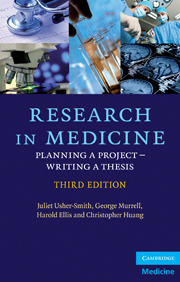Book contents
- Frontmatter
- Contents
- Preface
- 1 Introduction
- 2 Deciding whether to do research
- 3 Deciding when to do research
- 4 Selecting a research degree
- 5 Choosing a department, research supervisor and project
- 6 Applying for research positions and funding
- 7 Getting started
- 8 Overcoming frustration
- 9 Writing scientifically
- 10 Publishing a paper
- 11 Attending scientific meetings
- 12 Writing a thesis
- 13 Submitting a thesis and preparing for the viva voce examination
- Further reading
- Appendix: Information for research students wishing to study overseas
- Index
9 - Writing scientifically
Published online by Cambridge University Press: 05 May 2010
- Frontmatter
- Contents
- Preface
- 1 Introduction
- 2 Deciding whether to do research
- 3 Deciding when to do research
- 4 Selecting a research degree
- 5 Choosing a department, research supervisor and project
- 6 Applying for research positions and funding
- 7 Getting started
- 8 Overcoming frustration
- 9 Writing scientifically
- 10 Publishing a paper
- 11 Attending scientific meetings
- 12 Writing a thesis
- 13 Submitting a thesis and preparing for the viva voce examination
- Further reading
- Appendix: Information for research students wishing to study overseas
- Index
Summary
How you structure your writing and express your ideas profoundly influences your readers’ and, more importantly, your examiner's impression and understanding of your work. A small number of talented, experienced and much practised writers are able to write quickly and fluently, but most of us require considerable effort to make our writings acceptable. The brief remarks in this section cover the important steps to be taken when writing, and may provide some help on how to compose scientific prose and indicate some of the reasons why a given piece of scientific writing may be unsatisfactory. However, they cannot replace more substantial volumes on the use of English, to which the reader must refer if he or she wants more definitive details.
Decide what to say
The first step in writing is to be absolutely clear as to what you want to say. The best English in the world will not compensate for a writer with nothing to report. Note down in a rough, not necessarily logical, fashion a list of the points you wish to make. They can then be ordered later, or in the course of writing.
Organize what you wish to say
Determine how your writing needs to be organized. This will vary depending on whether you are writing a progress report, a research paper or your thesis. Broadly speaking, though, most scientific writing follows the IMRaD style (Introduction, Methods, Results and Discussion) and includes the following sections.
- Type
- Chapter
- Information
- Research in MedicinePlanning a Project – Writing a Thesis, pp. 75 - 86Publisher: Cambridge University PressPrint publication year: 2010

